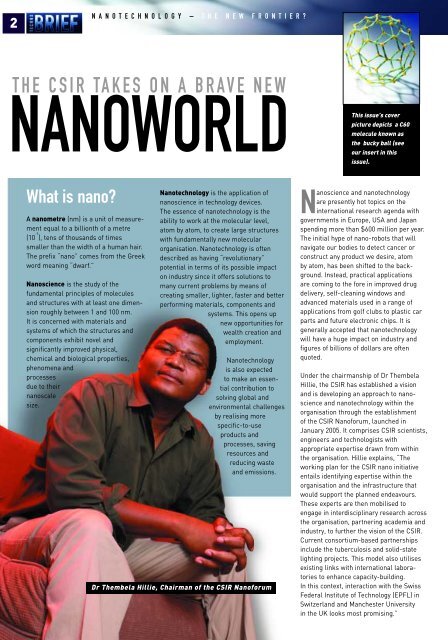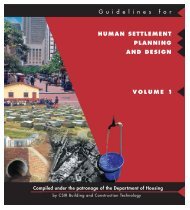2N A N O T E C H N O L O G Y – T H E N E W F R O N T I E R ?THE <strong>CSIR</strong> TAKES ON A BRAVE NEWNANOWORLDThis issue’s coverpicture depicts a C60molecule known asthe bucky ball (seeour insert in thisissue).What is nano?A nanometre (nm) is a unit of measurementequal to a billionth of a metre(10 -9 ), tens of thousands of timessmaller than the width of a human hair.The prefix “nano” comes from the Greekword meaning “dwarf.”Nanoscience is the study of thefundamental principles of moleculesand structures with at least one dimensionroughly between 1 and 100 nm.It is concerned with materials andsystems of which the structures andcomponents exhibit novel andsignificantly improved physical,chemical and biological properties,phenomena andprocessesdue to theirnanoscalesize.Nanotechnology is the application ofnanoscience in technology devices.The essence of nanotechnology is theability to work at the molecular level,atom by atom, to create large structureswith fundamentally new molecularorganisation. Nanotechnology is oftendescribed as having “revolutionary”potential in terms of its possible impacton industry since it offers solutions tomany current problems by means ofcreating smaller, lighter, faster and betterperforming materials, components andsystems. This opens upnew opportunities forwealth creation andemployment.Nanotechnologyis also expectedto make an essentialcontribution tosolving global andenvironmental challengesby realising morespecific-to-useproducts andprocesses, savingresources andreducing wasteand emissions.Dr Thembela Hillie, Chairman of the <strong>CSIR</strong> NanoforumNanoscience and nanotechnologyare presently hot topics on theinternational research agenda withgovernments in Europe, USA and Japanspending more than $600 million per year.The initial hype of nano-robots that willnavigate our bodies to detect cancer orconstruct any product we desire, atomby atom, has been shifted to the background.Instead, practical applicationsare coming to the fore in improved drugdelivery, self-cleaning windows andadvanced materials used in a range ofapplications from golf clubs to plastic carparts and future electronic chips. It isgenerally accepted that nanotechnologywill have a huge impact on industry andfigures of billions of dollars are oftenquoted.Under the chairmanship of Dr ThembelaHillie, the <strong>CSIR</strong> has established a visionand is developing an approach to nanoscienceand nanotechnology within theorganisation through the establishmentof the <strong>CSIR</strong> Nanoforum, launched in<strong>January</strong> <strong>2005</strong>. It comprises <strong>CSIR</strong> scientists,engineers and technologists withappropriate expertise drawn from withinthe organisation. Hillie explains, “Theworking plan for the <strong>CSIR</strong> nano initiativeentails identifying expertise within theorganisation and the infrastructure thatwould support the planned endeavours.These experts are then mobilised toengage in interdisciplinary research acrossthe organisation, partnering academia andindustry, to further the vision of the <strong>CSIR</strong>.Current consortium-based partnershipsinclude the tuberculosis and solid-statelighting projects. This model also utilisesexisting links with international laboratoriesto enhance capacity-building.In this context, interaction with the SwissFederal Institute of Technology (EPFL) inSwitzerland and Manchester Universityin the UK looks most promising.”
3From leftto right,Dr SibusisoSibisi,Dr ThembelaHillie andProf KlausKern atthe <strong>CSIR</strong>President’sLectureIn his address at the launch of the<strong>CSIR</strong> Nanoforum, Hillie said, “Theknowledge-base we establish mustensure that society can reap the benefitsthrough the establishment of newproducts and processes. Our approach,as informed by national priorities, istwo-pronged; one component willaddress social priorities such as health,water and energy and the other willincorporate industry focusing on novelmaterials, and nanoscience beneficiationof minerals and processes, tomention a few. To this end, theNanoforum is in line with the <strong>CSIR</strong>mandate to foster industrial andscientific development with our partnersto contribute to the improvement of thequality of life of the people in SouthAfrica.”The <strong>CSIR</strong> nanotechnology initiative willbe guided by both the South African andthe <strong>CSIR</strong> internal baseline studies onnanotechnology, which will determinethe selection of appropriate projects forcapacity development in both humancapital and infrastructure. The Forumcomprises four subcommittees, focusingon project collaboration, locally andinternationally, including fund-raising;capacity development in human capitaland infrastructure; stakeholder andpublic debates to ensure a commonresponse; as well as development ofnetworks in the health, safety and environmentalarena. Hillie also acknowledgesthe Department of Science andTechnology for their support in bothinfrastructure development and humanresources capital.Hillie confirmed that Prof Klaus Kern,of the Max-Planck Institute for SolidState Research in Germany, has agreedto serve on the <strong>CSIR</strong> InternationalAdvisory Panel, a platform createdto advise the <strong>CSIR</strong> on its nanoinitiativesand assist with capacitybuilding.This panel will alsoorganise access to establishedinternational laboratories forpost-graduate programmes todevelop human capital. Invitedspeaker at the <strong>CSIR</strong> President’sLecture held in <strong>January</strong> <strong>2005</strong>, Kernaddressed the <strong>CSIR</strong> on the potentialimpact of nanotechnology onindustry and highlighted the latesttechnological advances andresearch efforts in nanometrescalescience and technology.Another guest speaker at the launchof the <strong>CSIR</strong> Nanoforum,Dr Solomzi Makohliso, founder andCEO of Ayanda Biosystems SA,based in Switzerland, has beenmandated through the Swiss StateSecretary of Science and Researchto develop a long-term strategy forthe Swiss government to engage inscientific and technologicalcollaboration with South Africa.Said Makohliso, “I believe thatnanoscience and nanotechnologyshould form one of the pillars ofsuch a strategy, given the commercialpotential of this field. However,the development of a sound nanoactivityin South Africa would requirea multi-disciplinary interactionbetween government, industry andacademia. In my opinion, the <strong>CSIR</strong>is the best-positioned institution tospearhead a nano-initiative in SouthAfrica, due to its well-establishedrelationships with the various keystakeholders.”Manfred Scriba, demonstratingthe synthesis of carbon nanotubesNanotechnologyin South AfricaMobilising a country into action around anew technology such as nanotechnologyis no easy task. Nanotechnology officiallytook off in South Africa in 2002 guided bythe Department of Science andTechnology (DST). Over the last two years,the South African Nanotechnology initiative(SANi) has built a network of scientistsand engineers who are interested oractive in nanotechnology R&D, and hasbeen responsible for general awareness,networking and the formulation of aSouth African nanotechnology strategyfor the DST. Nanotechnology relatedactivities are also being implementedthrough the Advanced ManufacturingTechnology Strategy.Manfred Scriba of the <strong>CSIR</strong>, elected asthe first chairman of the SANi, played asignificant role in motivating government,academia and industry to take action inthis arena. At the same time, he ensuredthat the <strong>CSIR</strong> remained involved with theestablishment of an interest group thatlaid the foundation for the establishmentof the <strong>CSIR</strong> Nanoforum. Scriba, who onthe technical level has built an AtomicForce Microscope demonstrator and,together with Dr Thembela Hillie, synthesisedcarbon nanotubes, has supportedand motivated many young (and old) scientiststo start and continue their work innanotechnology. Says Scriba, “I hope thatthe initial mobilisation efforts will inspireour young scientists to see nanotechnologyas an opportunity to make bigthings possible in future.”
















